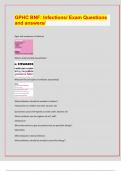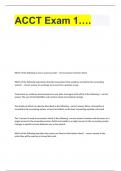EMR test questions | Questions & Answers (100 %Score) Latest Updated 2024/2025
Comprehensive Questions A+ Graded Answers | 100% Pass
1) The best strategy for assessing a 2-year-old child is to:
a. touch the head first
b. remove the child's clothing.
c. have the parent hold the child.
d. have the child examined by an EMR of the same gender. - ✔️✔️C: Toddlers, or children one to three
years of age, should be examined in a head-to-toe manner, as touching the head first may frighten the
child. Toddlers do not wish to be separated from their parents; thus, the child should be held by a
parent during the examination. Because toddlers dislike having clothing removed, only one article of
clothing should be removed at a time and replaced immediately after examination. It is not necessary
for the EMR to be the same gender as the child; however, in the case of an adolescent, the physical
examination should be conducted by an EMR of the same gender.
2. Which of the following statements regarding the fontanelles in infants is false?
a. The fontanelles may bulge when the infant is crying.
b. The fontanelles may pulsate with each heartbeat.
c. The fontanelles at the top of the head does not close until 18 months of age.
d. The fontanelles at the top of the head closes at 10 months of age. - ✔️✔️D: The fontanelles, or soft
spots on the head of an infant, may bulge when the infant is crying or agitated and may pulsate with
each heartbeat; thus, they should only be assessed when the infant is quiet The largest soft spot,
located on the top of the infant's head, does not close completely until the infant is approximately 18
months of age.
3. Compared with adults, infants:
a. primarily breathe through the mouth.
b. primarily breathe through the nose.
c. breathe through the mouth when the nasal airway is obstructed.
,d. have more respiratory movement in the chest - ✔️✔️3. B: Compared with adults, infants primarily
breathe through the nose; thus, unlike adults, when the nasal airway is obstructed, infants do not
automatically breathe through the mouth. Because the diaphragm is the major breathing muscle in the
infant, more respiratory movement is seen in the abdomen than in the chest
4. Blood pressure is higher in:
a. females.
b. males.
c. shorter children. .,
d. inactive children. - ✔️✔️4. B: In children, blood pressure is dependent upon gender, age, and height.
Blood pressure is higher in males than in females, as well as in taller children vs shorter children. 'Blood
pressure is higher in children engaged in exercise or activity than in inactive children.
5. In the case of an infant with SIDS, the EMR should do aU of the following except:
a. attempt to diagnose SIDS.
b. provide resuscitation to the infant.
c. comfort the parents.
d. arrange for transport of the infant to a hospital. - ✔️✔️5. A: Because the EMR cannot diagnose sudden
infant death syndrome (SIDS), he or she should provide the infant with the same emergency care as a
patient in cardiac arrest. The EMR should provide resuscitation and arrange transport of the infant to
the hospital; however, resuscitation should not be attempted if rigor mortis has developed or the
infant's blood has pooled: Emotional support should be given to the parents.
6. Treatment of a child with a fever should include:
a. application of rubbing alcohol.
b. undressing the child.
c. bundling up the child.
d. bathing the child in cold water. - ✔️✔️6. B: Bundling up a child with a fever simply retains the heat of
the fever and is therefore ineffective; instead, the child should be undressed to his or her underwear or
,diaper. If the child becomes chilled, he or she should be covered with a light blanket. Applying rubbing
alcohol may allow toxic amounts to be absorbed through the skin. Children with fever should never be
submerged in cold water.
7. In an MCI, the EMR is expected to:
a. triage as many patients as possible.
b. provide care to as many patients as possible.
c. provide care to the walking wounded.
d. take copious notes on each patient - ✔️✔️7. A: In the case of a multiple-casualty incident (MCI), EMR
personnel are the first on the scene and are responsible for triaging as many patients as possible; triage
should only be stopped when a patient requires life-saving care. Patients with minor injuries, or the
walking wounded, should be directed to a location away from the scene of the emergency. Brief notes
should be taken on each patient; however, taking copious notes may delay the triage process.
8. According to the ST ART triage system, patients are classified as delayed if:
a. he/she is able to walk away.
b. he/she is unable to follow commands.
c. their radial pulse is absent
d. capillary refill is <2 seconds. - ✔️✔️8. D: According to the START triage system, a patient is classified as
delayed if respirations are <30 per minute, capillary refill is <2 seconds or radial pulse is present, and the
patient is able to follow commands. Patients who are the least injured and are able to walk away from
the scene are classified as minor.
9. In triage, a red tag indicates:
a non-salvageable status.
b. immediate status.
c. delayed status.
, d. deteriorated status. - ✔️✔️9. B: In triage, a red tag indicates immediate status; such patients are
unresponsive but able to breathe. Non-salvageable or deceased status is indicated by a black or gray tag
and delayed status by a yellow tag.
10. Which of the following statements regarding assessment of the circulatory system in children during
triage is false?
a. A nonbreathing child may still have a pulse.
b. In children, respiratory failure is followed by circulatory failure. c. Small children have a respiratory
rate >30 breaths per minute.
d. A respiratory rate of 8 breaths per minute in a child is normal. - ✔️✔️10. D: In children, circulatory
failure follows respiratory failure; thus, a nonbreathing child may still have a pulse. Small children,
particularly infants, have a respiratory rate >30 breaths per minute. According to the START triage
system, a respiratory rate of<30 breaths per minute in an adult is a positive sign; thus, a child with a
respiratory rate <8 breaths per minute would be classified as delayed when he or she is actually in
respiratory failure.
11. According to the JumpSTART triage system:
a. a nonbreathing child is classified as deceased.
b. a nonbreathing child should be assessed for a pulse. ,
c. a child who responds appropriately to pain is classified as immediate.
d. a child who breathes spontaneously after ventilation is classified as delayed. - ✔️✔️11. B: According to
the JumpSTART triage system, a nonbreathing child should be assessed for a pulse; if the child does not
begin to breathe spontaneously after the airway is opened, he or she should be ventilated five times. If
the child begins to breathe spontaneously after ventilation, he or she should be classified as immediate.
A child who is alert and responds appropriately to pain should be classified as delayed.
12. All of the following statements regarding the palpation method of obtaining blood pressure are false
except:
a. palpation measures only diastolic blood pressure.
b. A stethoscope is used for palpation.






